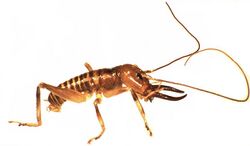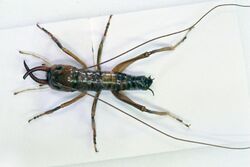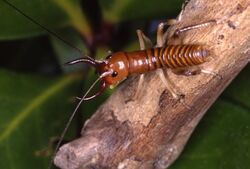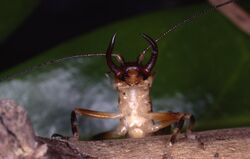Biology:Northland tusked wētā
| Northland tusked wētā | |
|---|---|

| |
| Scientific classification | |
| Domain: | Eukaryota |
| Kingdom: | Animalia |
| Phylum: | Arthropoda |
| Class: | Insecta |
| Order: | Orthoptera |
| Suborder: | Ensifera |
| Family: | Anostostomatidae |
| Genus: | Anisoura Ander, 1932 |
| Species: | A. nicobarica
|
| Binomial name | |
| Anisoura nicobarica Ander, 1932
| |
| Synonyms | |
| |

The Northland tusked wētā, Anisoura nicobarica, is a rare monotypic wētā of the family Anostostomatidae, endemic to the northern half of Northland in New Zealand, and originally described in 1932.[1][2] The type specimen was wrongly labelled as coming from the Nicobar Islands, so the species was named Anisoura nicobarica.[3][4] It was erroneously described again in 1950 by a different author, who placed it in the ground wētā genus Hemiandrus (as Hemiandrus monstrosus).[5]
Description

Tusked wētā are distinctive because of the long curved "tusks" adult males have projecting forward from their jaws. The tusks are not used for biting but are used to push an opponent.[6] Among the three species of tusked wētā, the Northland tusked wētā, Anisoura nicobarica, is the smallest measuring up to 21mm in body length. The Middle Island tusked wētā, Motuweta isolata, being the biggest measuring up to 70 mm in body length and the Raukumara tusked wētā, Motuweta riparia, is 30–40 mm long.[6][7] The Northland tusked wētā is reddish brown and their hind tibia contains small spines.[8] The tusks are devoid of stridulatory ridges, which are a feature of both M. isolata and A. nicobarica[9]. Unlike ground wētā (Hemiandrus sp.), tusked wētā have ears on their front legs (fore-tibia).
Habitat
The Northland tusked wētā is arboreal so needs native forest and scrub. Similar to the tree wētā, Hemideina thoracica, both species occupy holes (galleries) in manuka and other trees and shrubs during the day.[9] Unlike tree wētā, the tusked wētā makes a seal to close the hole entrance. Because the Northland tusked wētā hides in hollow branches and trunks of manuka it is often found associated with firewood.[10]
Distribution and abundance
Anisoura nicobarica are endemic to the Far North of New Zealand. In 1948 a specimen was found at Orokawa Bay in the Bay of Islands.[8] Most subsequent sightings have come from the Hokianga region.[8] Most sightings involve only a single individual, making their abundance hard to determine. Northland tusked wētā are nocturnal and during the day they hide in tree holes and cover the entrance, making them hard to find.[11]

Diet
Like other tusked wētā species, the Northland tusked wēta prefers feeding on an animal diet consisting of live and dead insects and spiders.[12][8]
Behaviour

Anisoura nicobarica lives in tree holes (galleries), while the other two species of tusked wētā are ground burrowers, and all three face outward while occupying the retreat.[13] As a defence tactic the tusked wētā orients itself to face the opening of its gallery with its jaws agape.[14][9] They also mix their saliva with wood scrapings to seal the entrance of their gallery making the aperture almost invisible which is especially important during their moult.[9] A captive A. nicobarica has been recorded creating a burrow in soil and roofing it with debris which suggests they can be flexible over their selection of refuges.[15][9] When any of the tusked wētā are provoked further they display " mandible gape", "raise foreleg" and "raise head" which closely resemble a suit of components displayed by Hemideina species.[9] According to Bellingham, M. (1991) during a field observation stated "when disturbed, they raised their tusks slightly, rasping them together. The body was curved sideways[9] with the front and head elevated. The hind legs were not raised. The weta also made short lunges forward attempting to use its tusks as pincers. When disturbed further, by blowing or tapping lightly on its head, the weta jumped away[14] haphazardly".[16]
Conservation status
The Northland tusked wētā are classified as "Relict" in the New Zealand Threat Classification System.[17]
References
- ↑ Johns, P. M. (1997). "The Gondwanaland Weta: Family Anostostomatidae (Formerly in Stenopelmatidae, Henicidae or Mimnermidae): Nomenclatural Problems, World Checklist, New Genera and Species". Journal of Orthoptera Research (6): 125–138. doi:10.2307/3503546. ISSN 1082-6467. https://www.jstor.org/stable/3503546.
- ↑ "genus Anisoura Ander, 1932: Orthoptera Species File". http://orthoptera.speciesfile.org/Common/basic/Taxa.aspx?TaxonNameID=1132122.
- ↑ Trewick, Steven A.; Morgan-Richards, Mary (2004). [0185:PONZTG2.0.CO;2/Phylogenetics-of-New-Zealands-tree-giant-and-tusked-weta-Orthoptera/10.1665/1082-6467(2004)013[0185:PONZTG]2.0.CO;2.full "Phylogenetics of New Zealand's tree, giant and tusked weta (Orthoptera: Anostostomatidae): evidence from mitochondrial DNA"]. Journal of Orthoptera Research 13 (2): 185–196. doi:10.1665/1082-6467(2004)013[0185:PONZTG2.0.CO;2]. ISSN 1082-6467. https://bioone.org/journals/Journal-of-Orthoptera-Research/volume-13/issue-2/1082-6467(2004)013[0185:PONZTG]2.0.CO;2/Phylogenetics-of-New-Zealands-tree-giant-and-tusked-weta-Orthoptera/10.1665/1082-6467(2004)013[0185:PONZTG]2.0.CO;2.full.
- ↑ Pratt, Renae C; Morgan-Richards, Mary; Trewick, Steve A (2008). "Diversification of New Zealand weta (Orthoptera: Ensifera: Anostostomatidae) and their relationships in Australasia". Philosophical Transactions of the Royal Society B: Biological Sciences 363 (1508): 3427–3437. doi:10.1098/rstb.2008.0112. PMID 18782727.
- ↑ Steven A. Trewick, Mary Morgan-Richards (2004) Phylogenetics of New Zealand's tree, giant and tusked weta (Orthoptera: Anostostomatidae): evidence from mitochondrial DNA. Journal of Orthoptera Research 13:185-196
- ↑ 6.0 6.1 "Tusked wētā". 2020. http://wetageta.massey.ac.nz/Text%20files/tuskweta.html.
- ↑ Winks, C. J., Fowler, S. V., & Ramsay, G. W. (2002). Captive-rearing of the Middle Island tusked wėtä.
- ↑ 8.0 8.1 8.2 8.3 Sherley, Greg H (1998). "Threatened Weta Recovery Plan". https://www.doc.govt.nz/globalassets/documents/science-and-technical/tsrp25.pdf.
- ↑ 9.0 9.1 9.2 9.3 9.4 9.5 9.6 Gibbs, G. W. (2001). The biology of wetas, king crickets and their allies. CABI Pub. ISBN 0-85199-408-3. OCLC 46631789. http://worldcat.org/oclc/46631789.
- ↑ Wise, K. A. J. (1990). "Families and populations or records of two species of Orthoptera". WETA 13 (1): 1–3.
- ↑ "Anostostomatidae" (in en). https://guaminsects.myspecies.info/taxonomy/term/3340/descriptions#Tusked_weta.
- ↑ Project Island Song. (2014). Project Island Song Translocation Feasibility and Action Plan. Retrieved form https://www.projectislandsong.co.nz/images/PIS-images/the-project/species-reintroductions/Project-Island-Song-Translocation-Feasibility-and-Action-Plan.pdf
- ↑ Gibbs, G. W. (1998). "Why are some weta (Orthoptera: Stenopelmatidae) vulnerable yet others are common?". Journal of Insect Conservation 2 (3/4): 161–166. doi:10.1023/A:1009660200402. https://link.springer.com/article/10.1023/A:1009660200402.
- ↑ 14.0 14.1 Messenger, G. (1992). A further record and notes on the Hokianga Tusked Weta. WETA. 15(2). 33-35
- ↑ Bellingham, M. (1991) Field observations of two species of tusked weta. The Weta (New Zealand Entomological Society) 14, 30–32.
- ↑ Bellingham, M. (1991). Field observations on two species of tusked weta. WETA. 14. 30-32
- ↑ Trewick, S. A.; Morris, S. J.; Johns, P. M.; Hitchmough, R. A.; Stringer, I. A. N. (2012-07-01). "The conservation status of New Zealand Orthoptera". New Zealand Entomologist 35 (2): 131–136. doi:10.1080/00779962.2012.686318. ISSN 0077-9962. https://doi.org/10.1080/00779962.2012.686318.
External links
Wikidata ☰ {{{from}}} entry
 |

